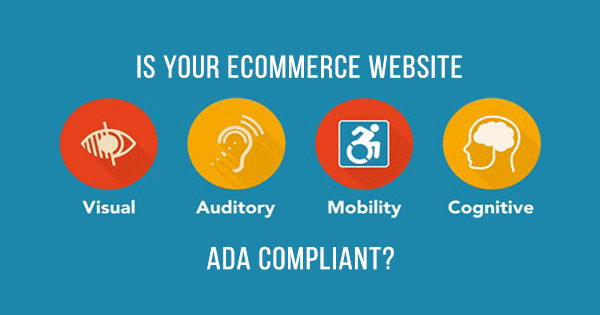Make your Magento website accessible to everyone through our Magento ADA compliance service. Learn more.
The importance of The American Disabilities Act (ADA) in the eCommerce and IT vertical has become prevalent and supercritical with the 2010 amendment of the ADA act. Organizations have started realizing the opportunity for compliance and the consequences of non-compliance.Let’s first understand on what’s the core purpose of ADA and later let’s focus on how this might have an impact in the way we look at business.
What is Disability?
The ADA defines a person with a disability as “a person who has a physical or mental impairment that substantially limits one or more major life activity.”
Here physical impairment could be visual (blindness, low vision, and color blindness), muscular issues, Parkinson’s disease, hearing impairment, epileptic seizures, and a few more. Mental impairment could be dyslexia, problem-solving, cognitive disabilities, and so on.

What is Accessibility (a11y)?
Concerning eCommerce, Accessibility – also referred to as a11y (Just that there are 11 characters between ‘a’ and ‘y’) plays a crucial role in aligning business groups towards ADA compliance.
a11y refers to the design of products, devices, services, or environments for people who experience disabilities. With responsive designs (rendering on Tablets/Mobiles and other form factors), the need for a11y becomes supercritical for people with disabilities.

Why should companies be ADA compliant?
First and foremost reason is that we have the social responsibility to build products and provide services for everyone in our ecosystem to have convenient access to everything. And for business groups, this would increase their brand value.

And the last reason why organizations need to be compliant is that failure to comply with ADA might attract fines/lawsuits filed against organizations. Furthermore, the government also provides incentives for businesses to be ADA compliant. Qualifying businesses may claim a credit of up to 50 percent of eligible access expenditures like communications, interpreters, and other auxiliary aids that exceed $250 but do not exceed $10,250(Source: ADA website)
When is the last date for business to be ADA compliant?
There aren’t any clear guidelines to the timeframe when ecommerce websites need to be ecommerce ADA compliant. However, it is advisable to be ADA compliant earlier rather than later not just because of the regulation or the lawsuits, but more because we are obliged to provide access to resources for everyone in our ecosystem and show respect for our fellow friends.
This is the attribute which people around us appreciate and hence enabling the organization to stand out uniquely. Subsequently, the brand value (intangible) and business (tangible) also increases.

How to implement ADA compliance in your business?
ADA compliance might not be rocket science, where we might have to change things drastically/overnight. We did some research across multiple websites in various categories, and put down the critical ones which were missed on most websites.
- First things first: Align to the basic coding standards like having the “ID”s unique, having appropriate naming conventions, and so on.
- Keep looking at things from the perspective of a person who is disabled. For instance:
- Think of someone using a magnifier (or zooming in web browsers) to read the text: will the text get rendered correctly for him; will he still be able to click on an image and the clickable portion is also aligned.
- Think of someone who has low vision (or) someone who is color blind: will he be able to see the text if the contrast between foreground and background are not prominently distinct. ADA recommends Contrast ratio to be maintained at 4.5:1 for standard text, or 3:1 for larger text.
- The most common issue across most websites was that web elements (images, text box, checkbox or any item within site) do not have alternate text. Think of a situation where a blind person is trying to access the website and when he clicks on any image, and the viewer reads “image” and does not tell anything about the picture. Doesn’t it look annoying for the end user here?
Giving a good alternative text is an art, and it becomes supercritical in today’s world as it also improves your SEO ratings. This link walks you through giving an excellent alternative text.
- “Skip to main Content” option should be available which helps the user to navigate to the required tabs with minimal navigation. Refer to the below video.
- All functionalities should be accessible from the keyboard. For instance, if the website has scripts embedded in it, provisions for accessing them from keyboard should be possible.
- Captions need to be mentioned for all multimedia files.
- Explicit error messages are to be displayed to all users. Rather than having “Form submission is wrong,” it is better to have a more specific error message like “The age should be more than 18”.
- All tables should have appropriate column, and row headings associated with it and it should be tagged to the relevant header tags.
- For redirection to other sources (Like PDFs), there should be a link for PDF installer software.
- Headers to be appropriately tagged to heading tags (e.g. h1) rather than just making it bold.
- The required form fields should be tagged as “Required”. A blind user might not be able to see the “*” symbols as the other users can see.
- All documents should have proper titles associated with it.

- Sitemap must be tagged to all appropriate pages.
- The fonts used need to be available across all platforms (like MAC, Windows etc.)
- Having an accessibility guide could help persons with disabilities to understand the accessibility features and how to play around with them.
- Provide a way for visitors to request accessible information or services by posting a telephone number or email address on your home page. Establish procedures that ensure a quick response to users with disabilities who are trying to obtain information or services in this way.
- Periodically enlist disability groups to test your pages for ease of use; use the feedback they provide to increase the accessibility of your website.
Will my business be ADA compliant if we follow the above list?
The above list is just the start. It gives us the idea of the most common ADA compliant issues. However, there are other parameters also which needs to be satisfied to be ADA compliant.
Get in touch with DCKAP to assess your ADA compliance. To know more, the check list could help – https://www.w3.org/TR/WCAG10/full-checklist.html
Contents




